How I chose my solar system setup (+ avoided unnecessary waste)
When I moved house, my number 2 priority was getting solar panels. (My number 1 priority? That was digging in the compost bin, of course!) I was pretty keen to get a solar system sorted as soon as possible, and as of Tuesday, my roof is now wearing 11 lovely panels and making me free electricity from the sun.
I posted a photo of my roof on social media, and received a few questions asking which company I’d gone with, and a lot of nervousness about making the ‘right’ choice or finding the ‘best’ company.

I get it! Solar systems might pay for themselves eventually but they are a big cost upfront, and the internet is a crowded place when looking for help and information.
I thought I’d talk you through my decision-making process, and how I came to choose the system that I have.
I’m not saying it’s necessarily right for you, but if you’re thinking about getting solar, some of the questions (and answers) will definitely be relevant.
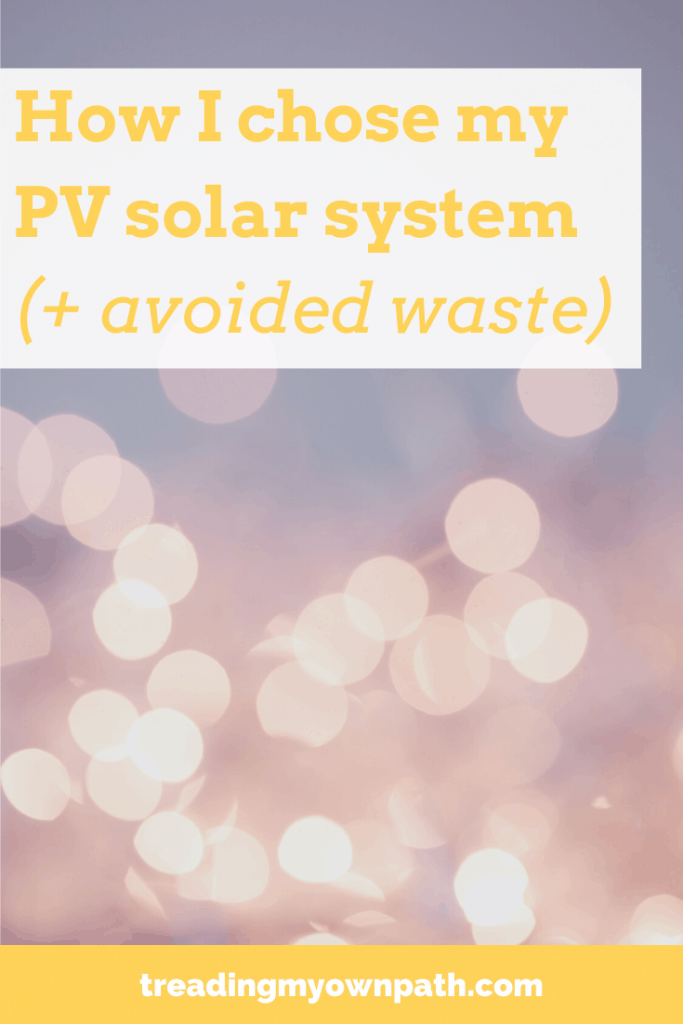
How Solar Systems Work – An Overview
Yes, solar panels make electricity from the sun. But beyond that, it’s important to understand how they work so you can choose a system that meets your needs, and not pay more for something that’s too big. That’s a waste – of your money and resources generally.
Solar panels make electricity when the sun hits them directly. In Australia and the southern hemisphere, this is on the north facing roof; in the northern hemisphere it’s the south-facing roof. Where I live, a north facing roof will get sunlight from 9am – 3pm (ish) in winter, and 8am – 6pm (ish) in summer (the sun never sets after 7.45pm here).
So that means I can use ‘free’ electricity during those hours, but outside of that, I still need to rely on the grid (or use a battery).
The excess electricity I produce during sunlight hours will go to the grid. Unfortunately it’s not as simple as giving electricity to the grid in the day and getting it back at night. Or at least, it’s not a simple exchange financially. I sell my spare electricity to the grid during the day for 7 cents a unit (this is called the feed-in tariff), but when I buy it back, it costs me 28 cents a unit.
Ouch.
Let me explain the numbers. When you receive your electricity bill, it will tell you how many units you use every day. If you’re a low electricity user and/or have gas, you might use 5 units per day. If you have a big house, with heaps of gadgets, you’ll use more. The Australian average is 19.8 units a day. It will also vary by seasons (winter means more heating).
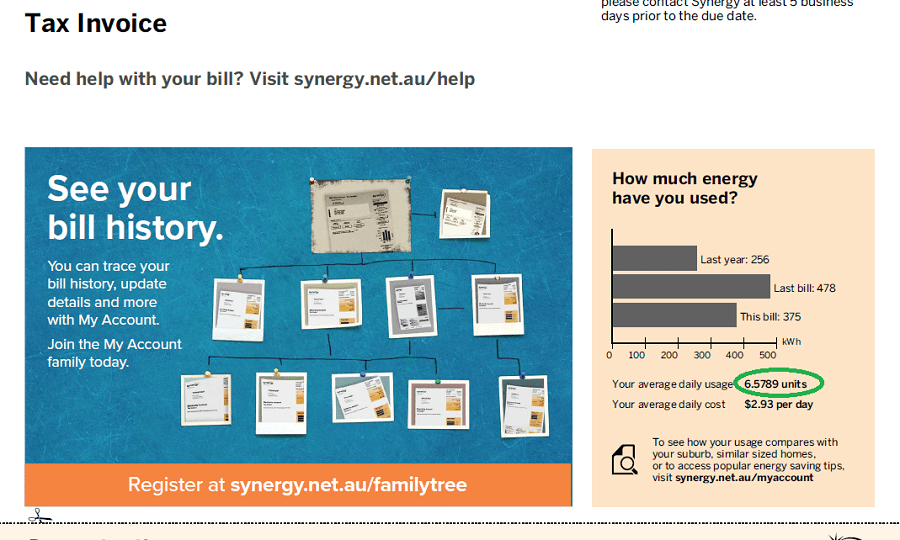
A unit is 1kWh, shorthand for 1000 watts per hour. When we talk about solar systems, we talk in kW – for example, a 1.5kW or 3kW or a 5kW system. What this means is every hour that the sun is shining, a 3kW system will produce ~3kW of power, meaning 3 units every hour.
Except this isn’t quite accurate, as panels and systems aren’t 100% efficient. In the morning or the evening they won’t crank at full power, nor if shaded, and once they reach 25°C/77°F they lose output efficiency – which can be 25%. (In Australia, panels tend to work better in spring and autumn than summer – black glass in full sun is going to get very hot very quickly.)
An average 3kW system might generate ~13 units per (sunny) day. (That’s 3 units per hour in the middle of the day, and a bit less in the early morning and late afternoon, and none that time the sun briefly went behind a cloud.)
Panels are usually 250 – 380W each depending on the brand, so 3-4 panels makes 1kW (1000 W). A 3kW system might have 10 – 12 panels.
Solar systems are made up of panels, and also an inverter. The solar panels use the sun to make direct current, and the inverter changes it to alternating current that can go into the grid/fed into the home.
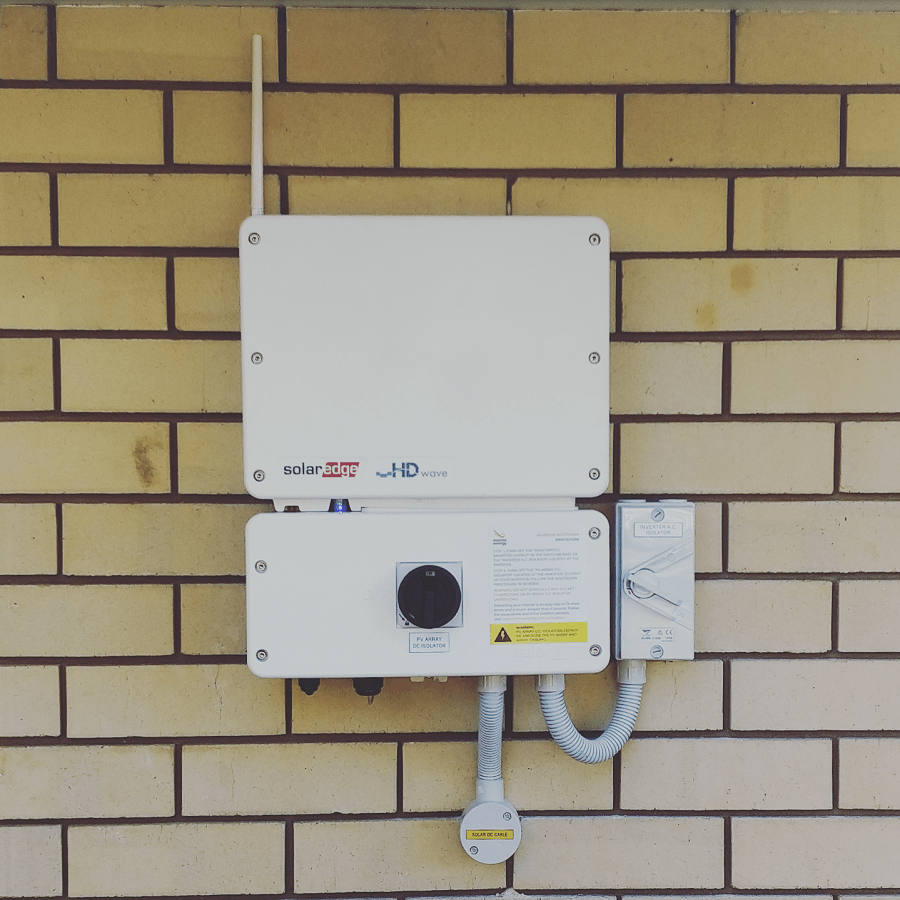
The inverter is the limiting component: if an inverter is 3kW it will only ever be able to produce 3kW per hour, even if you had 20 panels, adding up to 6kW.
Often the panels will go slightly higher than the inverter (for example, 3.84kW of panels for a 3kW inverter), to help offset some of the energy ‘lost’ as inefficiency.
How Big Does My Solar System Need to Be?
There are a few things to think about when choosing a solar system. These are three questions I asked:
- How much electricity do I use? (check previous bills);
- How big is the part of the roof that faces in the right direction? (north for southern hemisphere, south for northern hemisphere);
- What about battery storage?
Considering solar panels: how much electricity do I use?
I haven’t lived here long enough to know how much electricity I use, but I know that at my old place (which had separate solar hot water and no gas) I used 5 – 7 units a day. There was no air conditioning (the building was 10* energy rated) but I did use a heater sometimes in winter months.
I’m pretty careful with my electricity use, so it’s reasonable to assume that my electricity use might be the same, or a little bit higher (this place has air-con, which I might bust out on those 40°C/104°F + days in summer).
Considering solar panels: what is the orientation of my roof, and is that optimal for solar panels?
My roof doesn’t face north, it faces north-east. The back faces south-west, and the side faces south-east (there are only three sides as it’s a duplex/semi-detached). Not having north, north-east is best (because I’m in the southern hemisphere; if you were in the northern hemisphere, south and southern variations are best). Where I live, the south-west might pick up a bit of summer afternoon sun but would be useless in winter, and the south-east would be completely useless – in theory it might pick up a bit of morning summer sun, except there are heaps of trees on that side, so it’s in permanent shade.
The arc of the sun changes over the seasons. In winter it has a narrow arc that doesn’t get as high in the sky. In summer it rises further from the east, gets higher in the sky, and sets further to the west. The exact difference changes according to distance from the equator.
Because of the shape of the roof, I could fit 11 panels on the north-east side (which would be a 3kW system). Any additional panels would go on the south-west, only getting (some) summer afternoon sun.
Considering solar panels: is considering a battery an option?
Batteries in their current form don’t make sense (to me). Take the Tesla Powerwall, which holds 13.5kW of energy and costs around $9,000. If I use 7 units a day, I could use up the entire storage capacity in 2 days if the sun wasn’t shining. Then I’d need to buy power from the grid.
So a battery wouldn’t actually mean going off-grid.
When the sun is shining, of the 7 units I use a day, 2-3 units are outside daylight hours. To buy these costs me 28 cents a unit, so less than $1 a day. If I save $1 a day by having a battery, but that battery costs me $9000 to install, it will take 24 years to pay it off.
As a small user of electricity, I’m currently better off buying my evening electricity from the grid (well, if I actually had $9,000 to spend on a battery, which I do not).
Isn’t a bigger solar system ‘better’?
It’s easy to think that a bigger system is better. But that isn’t necessarily the case.
The issue is, most of us want to use at least some electricity when it’s evening, night time, overcast or raining. A bigger system isn’t going to do anything differently if there is no sun.
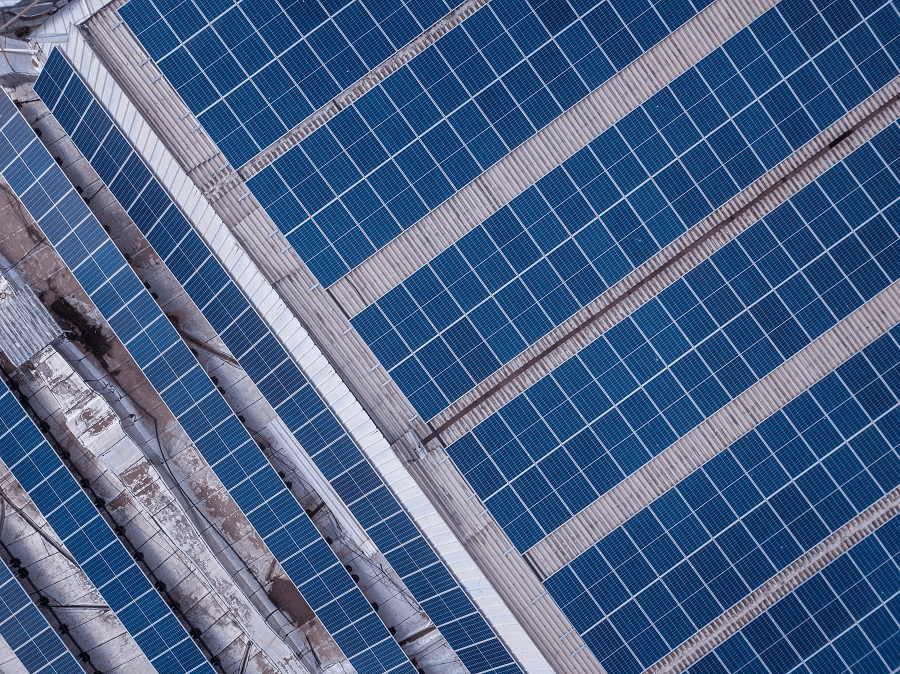
What about producing excess in the daytime? As I mentioned, I can sell my electricity back to the grid for 7 cents. That’s better than nothing, but it’s not a route to riches. Say I have a 3kW system that generates 13 units a day and I don’t use any of them (unlikely, as I keep my fridge plugged in even when I’m away).
Selling all 13 units to the grid, I’d make 91 cents a day.
The reality is I’ll be using some of that myself, and when I need electricity in the evening, I buy it back at 28 cents. If I use 2-3 units in the evening, that’s my 91 cents gone.
That might seem cost neutral. Except, where I live, I also have to pay a connection fee to the grid: it’s $1.03 a day.
(The connection fee is also a tax on people who can’t afford solar panels. In 2014, it was 36 cents a day. As more people get solar panels, the electricity company needs to get money elsewhere, so it tripled the supply charge. The people who lose the most are renters and those who can’t afford solar panels.)
So I may be able to sell electricity to offset my evening usage, but I’m still paying $1 a day in service fees.
If I wanted to offset this cost, I’d need another 3kW of panels, generating another 13 units of energy a day.
Except, then there are those days when it’s overcast, or it rains. Those days don’t make any units, so there needs to be more panels to cover this.
Once you get more panels (which cost more) you also need a bigger inverter (which costs more). Not to mention more (correctly oriented) roof space. This extra cost might pay itself back over several years, but the prices for buying and selling electricity and the connection fee costs aren’t guaranteed, and could change.
If the government changed its mind about allowing customers to sell their excess back, I wouldn’t get anything for what I didn’t use.
It makes more sense to get the smallest system you need to generate the power that you actually use, rather than going bigger and then selling the excess back to the grid.
I know for me, a smaller system means I will be more careful with the electricity I use. A bigger system would encourage me to be more lax, choosing less energy-efficient appliances, perhaps.
How to choose a solar system that lasts (and continues to work)
At my previous address, I had solar panels (installed when I moved in). After 18 months, they stopped working. There was no power to the inverter. I called the builder, who told me the developers had decided to organise the solar panels themselves because they were cheaper, and that the company they had used were going to be hard to chase up and that I would need to call them every day.
Which I did – to their call centre in India – for 8 months. When I moved out 18 months later, the panels were still not fixed, despite having a warranty on parts and labour.
This time I was very clear I was using a company that was based in Australia, with a local office I could call and a good reputation. I also wanted to ensure that the panels and the inverter I had were made by a reputable company, and had some kind of warranty.
Paying less money for a system that breaks and then cannot be fixed is not a good deal, in my mind.
Many panels have a 10 year warranty, however a few have a 25 year warranty (for performance and the product itself). We all know that things like to break the second they are outside the warranty, and I don’t want to have to replace the system and buy a whole other set of panels in 10 years.
Also, panels lose efficiency every year, and conventional ones may operate at only 80% in 25 years. Better ones guarantee higher returns.
Good inverters also come with a warranty: the longer, the more reliable you’d expect the inverter to be.
My solar system: what I chose
I chose a 3kW system (with 3.96kW of panels and a 3kW inverter). I think I could have made do with slightly less (maybe 2.5kW), but my roof is north-west, not true north, and being able to run the air-conditioner in summer is a privilege I’m looking forward to.
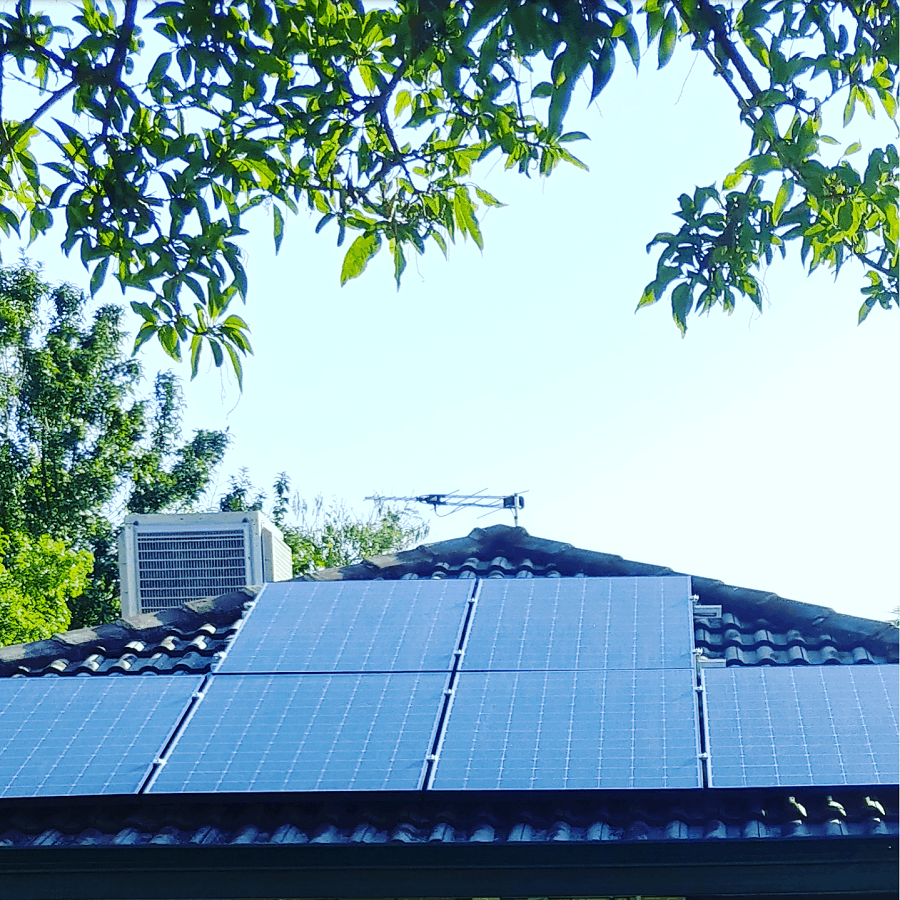
The panels have a 25 year performance and product warranty and the inverter has a 12 year warranty. With the savings made on my electricity bill, the system will have paid for itself in 6 years or so.
A top-end 3kW system actually cost the same as a mid-range 5kW system. Whilst it seems tempting to go for bigger, I knew that system was more than I needed and half the panels would only make electricity for a few months of the year (they’d have to go on the back roof). Choosing a system that’s guaranteed for 25 years (although I may have to replace the inverter) was more appealing.
For those interested, the company I used to install my solar system is Infinite Energy (the link is a refer-a-friend link, but I wasn’t paid or given any kind of discount to write this post). As I’ve only had my system for 2 days, I can’t speak about the longevity of the system (yet!) but to date, they’ve been helpful, efficient and quick in getting everything set up. So yes, based on what I know I’d recommend them.
Now I’d love to hear from you! Do you have solar? How do you find it works for you? Are you thinking of getting solar? Is anything is putting you off (aside from saving up the initial cost)? How do the feed-in tariffs work (or not) where you live? Any other thoughts? Please share in the comments below!
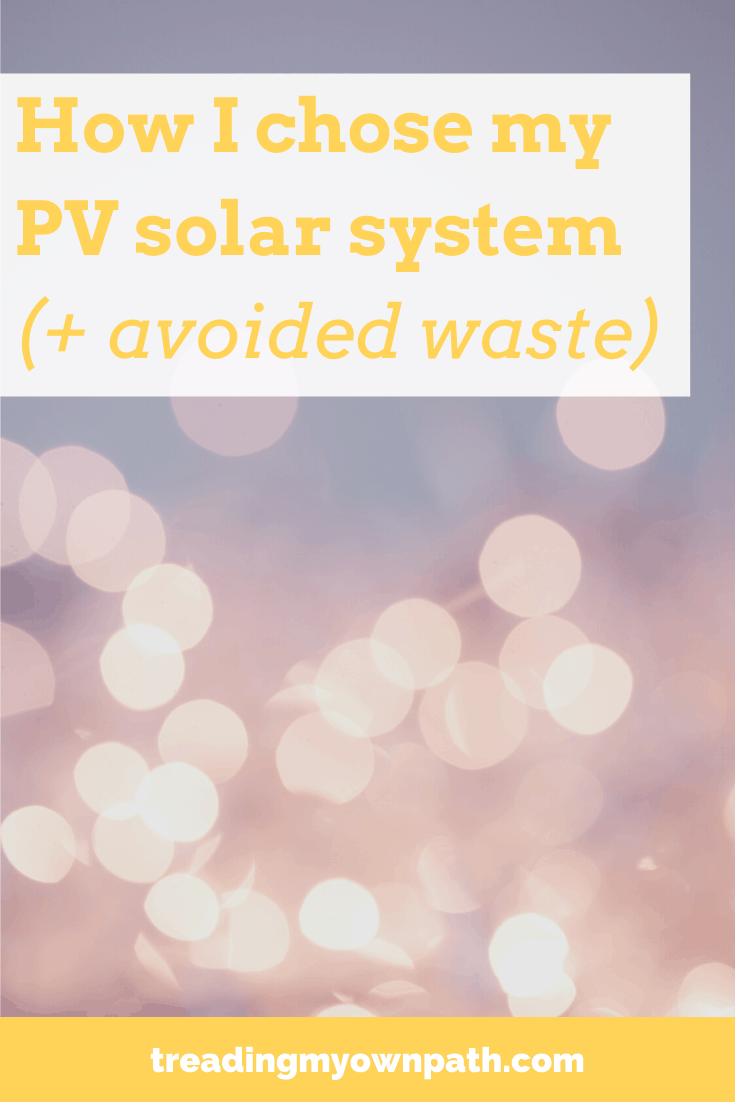







I have just listened to a talk about solar and the only thing I would add is that the expert recommends a Lithium Ion Phosphorous battery, the longevity of the battery (twice the Lithium Ion cobalt, Tesla, life span) would make sense for those who use most of their power after 6pm.
Thanks for the tip, Mark! The guy from the solar company was really excited about the technology around batteries, he seemed to think there were solutions with all kinds of materials. He also said it might be possible for people to use car batteries as a storage battery – so charge the electric car during the day and then run the house off the car battery at night. At least there are a lot of clever people looking at solutions!
The energy sector is in a real conundrum at the moment, world wide. People want three things from power – good price, good for environment and reliability. Unfortunately solar and wind are not reliable and the wind turbines cost millions to maintain. Coal is cheap and reliable but bad for environment. Gas turbines are efficient and good for environment but not cheap. Too much power on the grid can cause blackouts. Energy companies worldwide are trying to think up solutions because we can’t keep going as we are. Batteries may be our future but they’re soooo expensive! I agree with your post about not getting too many panels, not worth the dollars!
Thanks for sharing your thoughts! At least solar is fairly reliable in Perth – being the sunniest state capital (officially sunnier than Darwin and Brisbane). Well, within daylight hours, or course! I think there are more people in the UK than Australia with solar panels, which is crazy really. Yes, there is a real issue around distribution – way too much during the day and not enough in the evenings. It’s definitely not as simple as replacing all the fossil fuels with solar panels. If only…
Super useful post – thank you so much. I’m renting but there are a few options we can still consider. Your post has given me much to think about and some questions to make sure I cover.
The Victorian government currently has a rebate for Landlords for rental properties. I just put together a proposal for my landlord, to take advantage of the rebate.
If you’re not in Victoria there may be rebates in your state/country that could make solar an option for your Landlord to invest in solar for the property
That’s cool Sarah – do you have a link so I can read more? I don’t think they do that in WA currently, but maybe one day soon!
https://www.solar.vic.gov.au/
This website lists all the rebates in Australia and has a search function https://www.energy.gov.au/rebates
My pleasure Eve! It’s good to know about these things even if you aren’t in a position to do yourself yet. When I lived in my apartment I spent those three years going to all the Perth-specific gardening talks I could, so when I finally had my garden I was ready for action. Same thing. You don’t need to know it all, but paying a bit of attention to what’s happening is always a good thing!
Most informative and clearly and concisely explained .
Thank you
Mak
Pakistan
Thanks for your article Lindsay. After a number of years of procrastinating, we finally had a solar system installed at the end of 2017. This was following a free info session ‘Speed date a sustainability expert’ from our local council. Fabulous advice from an engineer/energy transition specialist there who also advised to join the Facebook page ‘My efficient electric home’ which is a great source of free information on solar and all things efficient and electrical. I am super glad that we installed a bigger system than I originally looked at – our total elec bill in 2018 was about 78% less than 2017, and gas bill reduced by about 75% since also replaced our ancient (& very noisy) split system with a new much more effiicent system, and then also our old gas hot water service (which was about to give up completely) with an electric heat pump HWS. We were also a net exporter of electricity to the grid i.e. overall we produced more than we consumed (although yes, obviously we sourced electricity from the grid when the sun wasn’t shining :-)). Company we purchased the solar system, HWS & split system from has been fantastic – director is an environmentalist in the business for all the right reasons and a delight to deal with. Feed in tariff ($ back from electricity company) different in different places – we get 12c per kWh, but this is likely to go up rather than down. A consumption monitoring app on my phone has also been good to guide electricity use and we have continued to reduce our use overall.
Enjoy your new solar system :-)
Hello Kylie, if you are in Perth would you mind mentioning the company you purchased through? We need to replace our old gas hws in the foreseeable future and I would like to go with an electric heat pump hws. Thank you, Katrina
G’day Katrina
I bought a house a couple months ago in Kalamunda (Perth, Western Australia for those elsewhere). Installed was an old, dying 3-phase electric instant HWS – crazy high power use. After 2 solid weeks of being torn between traditional roof top solar and an electric heat pump HWS I decided to go the latter.
There are plenty of options out there for heat pump HWS but be very careful – the cheaper ones are definitely not built to last which means a big waste of money and resource when you have to replace after a couple years.
My preference would have been a traditional roof top solar HWS – they are technically simpler, it’s pretty much set and forget and if you buy good quality you can expect 20+ years. Heat pumps are more complex and involve more electronic which leaves more space for malfunction. But due to a number of factors it was not a great option for my house – the very small section of north facing roof was a patio, so not structurally strong enough. It was also heavily shaded by some big old Marri trees which will be staying put.
I called most heat pump providers in Perth (and roof top solar HWS providers) to chew the fat and get as many options as possible before making a decision .
I found this website to be of massive assistance when it came to gaining base knowledge on all things solar. The bloke that owns the site/ company seems quite genuine. He runs it as a business throw the quoting side of things but he provides all information free of charge for anyone to read which I thought was very generous. Well worth a visit:
https://www.solarquotes.com.au/hot-water/type/
I’m by no means qualified in the topic but if you want to have a chat feel free to get in touch.
Hi Kylie, thanks for sharing your insights! I currently have a gas cooktop (electric oven) and gas hot water. I did look at the heat pump options but they are currently too expensive to justify – I think they are better for larger households. I also pay a gas connection fee (I think 40 cents a day) so my goal is to replace all the gas and just have electric, but that won’t be happening any time soon. I do have a portable electric induction cooktop I use for my workshops, and I’ve been using this in the mornings to boil the kettle rather than use gas! What’s the app you’ve been using to track consumption? I love geeking out over this stuff! ;)
We’ve had solar panels for 9 years, here in the north of England. That’s both PV and for heating water. We have a very good feed-in tariff because we got in at the beginning, and we get quarterly cheques which more or less balance the bills we pay for the grid electricity we have to use. We generate twice what we use in the summer months, but during the winter months (October to end of March) we use ten times more electricity than we generate. I try always to use my domestic machines in the middle of the day.
Hi Val, thanks for sharing! Here the sun doesn’t set that much differently in summer and winter – maybe 5pm in winter shortest days and 7.30pm in summer longest days – so nothing like the variation you get in the UK. I imagine in the summer months your panels are cranking! Good to hear you’ve got a good feed-in tariff, I did read that the UK actually scrapped them completely for a while!
Sadly, no one in my Central Texas neighborhood wants to eliminate the current Home Owner Association ban on solar panels on the roof that face the street. We can install on the other side but since that is not the most efficient, it is not worth the cost ~ currently. If I move to a non-HOA neighborhood sometime, and know I will be there longterm, I plan to seriously investigate.
Ugh, that must be so annoying Christine! My panels face the street, because that is where the best side is – I would be furious if I wasn’t allowed to put them there! (I also wouldn’t be able to have solar, if that were the case.) Also, I hadn’t heard of Home Owner Associations before, I don’t think we have them here. But we do have strata bodies for units and townhouses, which may be similar…
this was very informative—thank you!
sadly, so long as i am in my current house, solar is not an option for me. the HOA doesn’t permit panels here (nor clotheslines!), and my roof is east-west facing with many trees around it, anyway. our local electrical power company has some solar panel ‘farms’, so a percentage of our energy is green, but i suspect that it’s a pretty piddly amount compared to the great grubby (probably coal and/or oil fired) power station up-river that is the main source. still, it is a beginning to see them investing in solar farms…
thanks for sharing your knowledge.
I find it so strange that HOAs like to have opinions on this stuff. I wonder if slowly consensus will change and they will be all for it? Not soon enough, no doubt! I sometimes think solar is a bit of a poster child of the ‘being eco’ movement, but it’s by no means perfect nor the only thing we can do. In fact, when I started this blog and going on my waste journey, it was exactly because I rented and couldn’t do all the ‘textbook eco’ stuff like get solar panels. So I’m glad to have them, but under no illusion that I am single-handedly saving the world over here by popping a few panels on the roof! As you say, we need things like solar farms – bigger scale tech that is more accessible, and doesn’t create waste or use rare earth metals. There are plenty of good people working on solutions :)
Hi from NZ,
Well done. We got solar last March. It is working well especially since we have had to adapt to a solar lifestyle to benefit. My partner works from home so our aim is to use as much of what we produce as possible. The only problem is keeping your use to lower wattage activities. We use a bread maker to bake cakes as well as bread..550 W. A dehydrated to save rice and Dahl for tramping 550 W, A bench top oven for cooking dinner 1000W. All second hand appliances.. a sunny day is greeted with a plan. Don’t turn everything on at once..
Our hot water is trickled charged with any excess power. Once it is fully hot only then do we export to the grid.
Coming into summer we are now exporting 7 kw per day. 50 kw/ week. Despite our best attempts to use it. So we are contemplating an electric car. It makes more sense than a battery. I could bore you with the maths but. We export more than we need to use at night. (3kw system like you).
FYI. We have no subsidies here. Our buy back is 8c/ kw. We buy at 26.5c. our October bill was $35. For a total 350 units used. 120 paid for with network charges.
Kia kaha. Go strong
Fi
Hi Fi, thanks for sharing all this – I totally geek out on the maths so share away! At my previous place my solar system was 1.5kW so I was very conscious of choosing low wattage appliances. I had an induction cooktop, and would boil the kettle on 5 (mid-low setting) – it took ages but didn’t blow my solar budget! At least with 3kW I will have a bit more to play with, although now I’ve got the tracking set up it seems to sit more around 2.5kWh at peak.
The sales guy actually said that electric cars make more sense than batteries, and they were looking at tech to use the car as a battery at night (assuming you don’t need to drive early the next day). He did tell me all the costs but I forget. Out of my budget, I know that!
You seem to take the same approach as me, getting into all the details of it. So interesting! :)
Great article. It’s good to hear people’s experiences and situations. I look forward to hearing how the system is working in a year’s time.
I recommend anyone considering solar, to first look at and know your existing energy use.
If you can, borrow a meter reader to check all your appliances. See if you can reduce your energy consumption as much as possible before buying a system.
Regularly track your energy use – smart meters in Australia are linked to a portal provided by your energy retailer and can help you hone in on your energy use, even to the hour.
At the moment, in most Australian states, you are better off getting a system to provide for your own consumption as much as possible, and not be concerned with what you can export to the grid. Aim to reduce your demand on the grid. Whilst the cost of batteries is still high and the feed-in tarriff low (and able to be changed), if you can produce your own power this is good.
Then switch to using appliances only during the day, such as the washing machine, dishwasher, electric hot water (showers), electric heating & cooling, computers, electric ovens…
When the sun goes down switch to relaxing and sleeping! (minimum energy use)
I would also recommend looking at replacing gas appliances and gas hot water (and abolishing your gas connection) with very efficient electrical appliances, and making sure your solar can cover these too.
On those unbearable hot days, use solar to run your air-con in the morning, and then switch off and maintain a cool building in the afternoon – leaving your solar to feed-in to the grid in the peak time. This will help reduce risk of blackouts, that put our most vunerable in the community at risk.
This will also help build resilience, if you can produce the majority of your energy needs on site.
Thanks Sarah – all great thoughts and all things I’ve done over the past few years (definitely recommend borrowing an energy meter, or if you’re good at maths start checking the wattage of different appliances and do the unit calculations).
This house has gas (gas hot water and gas stovetop). My long term plan is to get rid of the gas – I also pay a supply charge for gas. I don’t have the budget for a heat pump water system, but maybe if the price comes down/my savings goes up I will invest. I did look at changing the cooker but it’s in a small space and there aren’t that many (I found one, and it was pricey) that are fully electric and would fit the space I have. I have a portable induction cooktop I use for workshops, and I’ve been using that to boil the kettle in the morning.
I know that research has shown that people who get solar can actually get blase about using power – because they think it is ‘free’. But it is quick to go over if you start using hungry appliances, or lots of things at once. I’m the opposite I think, I get really intrigued and try to minimise as much as possible. I do think a smaller system helps with this. If I had a 5kW system it would be easier to not pay as much attention…
Hi,
We put our gas hob onto an lpg bottle ,9kg. Legally plumbed in I assure. Then we swap it ourselves. No supply charge. We use 2 bottles per year. Freedom from supply companies.:-)
FYI in NZ some electricity companies are offering a very good night rate for EV owners. So in the dark of winter it is still cheap to charge.
One day there will be Vehicle to house bidirectional connections but not soon.
Cheers Fiona
G’day Lindsay
A tip of the cap for getting roof top solar straight away. One of the best ways to make it ‘cost efficient – or more so, worthwhile – is to install it asap so you can use it longer (as in the lifespan of the place you live).
You’ve definitely covered off a lot of the big pointers. If people want to take a slightly deeper dive into the world of solar can I suggest https://www.solarquotes.com.au
An Aussie electrical engineer that used to work for the CSIRO and seems to froth over all thing solar. He started his website a few years back and it’s choc-a-block full of really useful info – explanations of system components, how things work, ways to optimise, etc.
I’m pretty sure everything on the website is free – he generates an income via a free quoting system – and I’ve found he’s information and advice to be very unbiased. I’ve got no affiliation with him or the site, just happened to come across it when researching solar hot water/ heat pump systems and thought it was worth the share. A couple of the articles he wrote are what helped me decided on getting a heat pump HWS.
Keep the great blogs coming!
Hi Kyle, thanks so much for taking the time to comment :) Yes, I was keen to get it installed as soon as possible, in part because it takes time to offset the initial cost, and whilst (having just moved) I swear I’ll never move again, you never know what life is going to throw at you. Another reason was that just coming into summer here, it makes sense to do now when the days are longer and less cloudy. Clearly the output of the system varies with the seasons! And finally, not having any insulation in the roof, the panels will act as a bit of insulation to help keep the house cool. At least they are absorbing/reflecting the heat rather than my tiles now!
Thanks for the recommendation. I think I actually came across his site whilst doing some research – I have a 3 phase meter here, and a single phase inverter which is allowed up to 3kW. I’ve read some things about electricians setting up the meter so only one phase is connected to the solar, so those people might use electricity whilst their system is going, and still pay 28 cents whilst selling their electricity at 7c. I guess I won’t know for sure that it’s been set up correctly until I get my bill, but it does help to understand these things a little.
I’d love to know more on your thoughts on heat pumps, if you’ve time to share. The good and non-noisy ones (mine would have to go right behind the bedroom wall) seem expensive and have a huge payback period. But longer-term I do want to get rid of my gas connection… If you have any opinions on it, let me know!
G’day Lindsay
Are you set on a heat pump? Even though I went down that path my preference was and still is for traditional roof top solar. They are a much simpler system that will likely last much longer.
For me the biggest downside of roof top solar is the “need” to boost the system in winter. I use inverted commas because it is possible to avoid/ minimise this by being mindful of when you use your hot water (in winter only – you’ll have oodles of hot water throughout the day and night in summer). The system is going to have the most/ hottest water toward the end of the day because heated water from the collector panel has been filling up the tank. That’d mean night time showers are the go for winter. In the cooler months heat stored in the tank would dissipate into the cold night air so that by morning the water coming out the hot water tap was no longer hot. My partner is steadfast in having morning showers so every morning she’d turn the electric booster on to heat the water in the tank – a terrible inefficient and energy-hungry water heating method. There are automatic timers available to control if/ when the roof top solar system gets boosted which can potentially increase the efficiency during colder periods, but they’ll obviously add to the cost. And apparently there are PV direct-connected electric boosters that are being developed.
The other potential issue with the traditional system is appropriate roof space. With your PV panels taking up prime real estate on your roof there is the option of having a roof top solar system mounted on an frame on the SW side of your garage but with the panels still facing NE. This again adds to the cost and if aesthetics are important might not look sleek. Although it would throw that bit more shade on the un-insulated roof for part of the day.
Anyway, back to what you actually asked. My house has a reticulated gas supply to the house but I have nothing that runs on gas, so I didn’t want to open an account and pay a supply charge just to have a gas HWS (supply charges for my water/ power/ gas bills are always the larger than my usage charges!). Gas HWS are quite efficient, especially when compared to electric, but I’m working towards reducing my fossil fuel use. I didn’t have a suitable enough patch of roof for traditional roof top solar so had a heat pump installed.
We have a wide range of heat pumps available in Perth, from the cheap and nasty to quite a high quality. There are those made in China, Europe and Japan. Because areas of Perth have what a lot of manufacturers deem to be “hard” water (large proportion of reticulated water supply comes from the underground aquifer), companies stopped selling stainless steel tanks across the board regarding solar hot water systems – roof top and heat pumps. There was only 1 brand of roof top solar that offer a stainless steel tank in WA. This means all storage tanks will be glass enamel lined.
Most heat pumps are an all-in-one unit with the motor and tank enclosed all in the one housing, though the one Japanese offering to us in WA is a split style system where the tank and motor are both stand alone bits of equipment. I spent many an hour online and on the phone to find garner as much info as possible. I had a local plumber recommend a Bosch because it had a manual control panel so you can adjust the temperature and I think set the parameters of when the motor could kick in (eg: during sunlight hours). A cheaper unit (mid-range), I can’t really comment on quality as I haven’t encountered one.
The first guy I spoke to was an eco builder based down south and he planted the seed for heat pumps. He’s recommendation was for German brand (built in an eastern European country) called Stiebl Eltron. I came close to buying one of these. They come in 2 sizes – WWK 222 or 222H and the WWK 302 or 302H; the number indicates tank capacity and the H models include an additional electric boost element in case there are periods of high draw from the tank (eg: multiple consecutive hot showers) – this is a similar thing to the booster on a roof top solar system, so high power consumption when boosting. I had a couple of people recommend the Stiebl Eltron brand. They’re not common in Perth (but heat pumps in general aren’t common) but they’ve been doing it for years in Europe.
I had a few quotes come through for the cheaper units (typically Chinese built) but I wasn’t game tot go near them. In the end I wanted the system that was going to be the most efficient and most likely to last the longest. My primary focus was on reducing my impact, so a system that used the least amount of energy to produce hot water and that was least likely to brake down and need replacing. I wasn’t too focused on how long it’d take for the system to pay itself off – basically I had an old electric instant HWS that was knocking on death’s door and I needed a new system so I chose the most energy efficient I could for my circumstance. Plus I don’t know how much of a cost saving I would make with the switch because I had just bought the house so had no bill stats to crunch.
I opted to buy a Japanese heat pump. I first looked at the Sanden brand but they use a stainless steel tank so alas, I couldn’t buy one in Perth. If I was to order one from over east I’d need to find a plumber competent in installing them and if I wanted to maintain warranty on the tank, I’d have to have regular testing of the water supply to show it is within Sanden’s paramenters for quality. I had a a Reclaim Energy system installed. These are a Japanese made heat pump unit coupled with an Australian made glass enamel tank (Dux brand, which I was told by installer make a lot of the tanks used in the roof top solar systems of the big/ well known brands).
The reasons I decided to go with the Reclaim Energy:
– best quality components I could find
– from memory the best warranty available
– it qualified for the most STC’s (a sign that it is the most efficient too)
– split system, so if something needs replacing it’s only one component I have to replace and not the whole thing (if it was an all-in-one unit)
– uses CO2 as the refrigerant gas – much cleaner, safer and less environmentally harmful. Other companies use gases similar to those in aircon units so are environmentally toxic, or the newer, less toxic ones are highly flammable!
– split system can allow for more flexiblity in install location
– one of, if not the, quietest system on the market
– the controller allows for choice of operating times to optimise efficiency
– boosts (if needed) using the heat pump unit as opposed to a separate electric booster
Fully installed it cost me $4644 (this is after the rebate). You’d be in the same STC zone as me so price would likely be the same for you. The unit qualifies for 32 STCs which the company “paid” me $35ea via the rebate
As a comparison I had a quote for the Bosch 3000 heat pump fully installed for $2890. The company doesn’t do a lot of installs so they couldn’t give me feedback on any issues they’ve had.
The price I paid for my heat pump came in slightly cheaper than the quotes I was given for a good quality roof top solar install (by a few hundred dollars).
Sorry that was so long, I tend to waffle on.
I installed my heat pump in an area that noise isn’t an issue. To be honest, these things (Reclaim Energy) are probably quieter than the noise made by a split system aircon unit – the noise is insignificant and is only when the system is operating to heat the water, which would only be minutes at a time rather than hours.
I can’t vouch for other makes but they all have fact and stat sheets available which include their decibel output.
You’re more than welcome to see it in operation if you’re up in the hills sometime.
Thank you for this post! I don’t have solar but I’m thinking of getting it.
Hi Lindsey I am new to your blog and have found all this info really helpful. I may have missed it but just wondering if you are able to share the total cost you incurred?
Now a days solar panel is becoming a part of our life. The best thing of solar panel it does not harm our Environment. solar panels make electricity from the sun. while purchasing a solar panel you should know your needs of power.